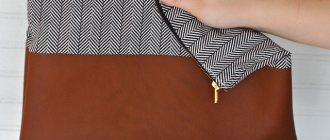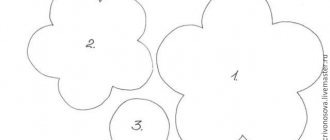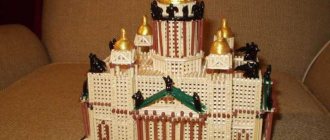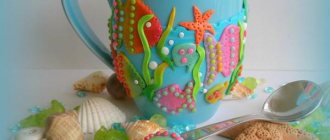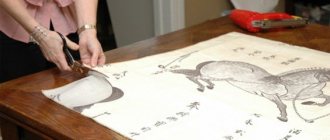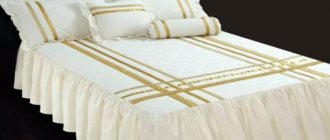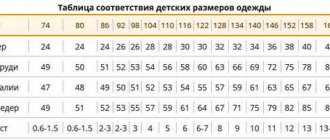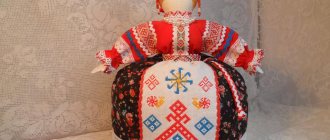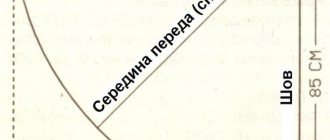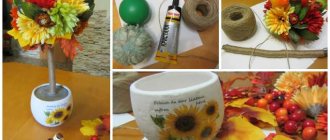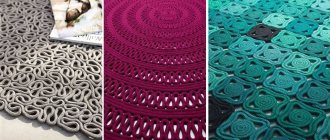Puffs on curtains give the curtains a luxurious look, bringing an atmosphere of sophistication and conviviality to the room. This is a special way of draping fabrics to decorate curtains. By collecting folds in the form of various patterns, you can create a beautiful composition used to decorate curtains in the living room, newlyweds’ bedroom or women’s lounge, even business offices and kitchens.
In French, this word means “lush, inflatable”, and in the Middle Ages, during the reign of kings, puffs were used as elements of clothing. Later, this decoration method was used when sewing curtains. Currently, puffs can be seen on curtains, clothes, shoes and even women's bags. As a rule, lambrequins are assembled in them. Large puffs are suitable for spacious rooms in a classic style with high floor-length windows, small folds are used in small apartments.
Types of buffs
Based on the sewing method, a distinction is made between hand-made and machine-made puffs. Sewing them for curtains by hand can take a lot of time, but it gives room for the dressmaker’s imagination and the opportunity to make compositions of varying complexity.
There are the following types of patterns for puffs:
- diamond;
- braid;
- flower;
- basket;
- Hungarian pattern;
- in the form of waffles;
- zigzag;
- English fold, etc.
Watch a video on the main types of buffs:
We will talk about how to make puffs on curtains. Every housewife who knows how to use a sewing machine, with a certain amount of patience and perseverance, can create an original composition with her own hands. Puffs can be made from ready-made curtains or fabric. Sewing them requires a large amount of material. You also need to purchase the following tools and materials for work:
- a simple pencil, felt-tip pen and crayons;
- a solid long ruler;
- scissors;
- sticky tape;
- a set of threads to match the color of the curtain or future composition;
- needles of various thicknesses and pins;
- iron.
Peculiarities
Puffs are tucks and folds in the fabric, made in the form of non-standard drapery methods. The result is textile compositions with a touch of luxury and exquisite romanticism. They are appropriate in the design of bedrooms for women or married couples, in the decor of formal offices or formal living rooms.
The technique that allows you to sew puffs on curtains comes from France, where it was first used by local needlewomen. Its essence is revealed in the translation of the word bouffer, meaning “to blow up.” From the very beginning, these lush elements were used to decorate the clothing of noble people. A little later, with the coming to power of Louis XIV, puffs began to be used to decorate luxurious rooms. And today anyone can sew ruffles on curtains.
Flounces on curtains are most often sewn from the inside of the fabric, only some elements are made from the front. At the same time, in order to get an intricate ornament, be sure to adhere to the pattern according to which the stitches are made.
This design method allows you to assemble lambrequins and puffs into artistic folds, which gives the room a festive, even slightly theatrical atmosphere. Large puffs make a pompous impression and are suitable only for rooms decorated classically. A tall window decorated with long floor-length curtains is considered ideal. If the window is decorated with small folds, then they are also appropriate in small spaces.
Choosing fabric for puffs
Before sewing curtains with puffs that match the interior of the room with your own hands, you need to choose the fabric wisely. The material depends on the room where the product will hang.
Very beautiful puffs are made from knitted fabrics that stretch well and fold beautifully. This type of fabric is suitable for the kitchen and small spaces.
It will also be interesting: We sew a curtain with a drawstring with our own hands - pattern, photo instructions
For the kitchen it is also recommended to use synthetic fabrics that are easy to wash. For large halls, puffs made of organza, silk, and tulle are suitable. As a rule, plain fabrics or small patterns are chosen for them, harmonizing or contrasting with the color of the curtains and the entire room as a whole.
Rich and noble fabrics are selected for living rooms and offices. Lambrequin puffs made of shiny or transparent fabric with shine add luxury and sophistication to the rooms.
In formal offices, as a rule, plain fabrics of strict colors are used, the folds are made small, without bulkiness. Curtains with lush puffs made of lightweight fabric with lurex or mother-of-pearl make the room light and cheerful. Such curtains are suitable for a child’s or young girl’s room. When heavy fabrics are used for puffs, special fillers are required to support the shape of the folds, which are made from sewing paper, padding polyester or pieces of thick fabric.
Hand-sewn curtains with puffs look especially ideal in rooms with a classic interior: walls with silk wallpaper, decorated with gilded monograms, massive furniture made of expensive wood. Curtains with frills made of light, airy fabrics are suitable for Art Nouveau rooms. If the goal of the work is to give the room elegance, it is better to choose puffs with a simple, unpretentious pattern; to emphasize the luxury of decoration - lush, with glitter and gold.
Execution algorithm
Types of puffs for curtains, including embossed and very complex ones, require patience and strict adherence to the drawing from the artist.
The general algorithm of actions includes the following steps:
- Selecting a pattern scheme.
- Transferring the ornament to the fabric (from the back or face).
- Arranging conditional points, piercing them with a needle and strong thread (this process requires care so that marks are not visible from the face of the fabric).
- Pulling the threads in a certain order, according to the schematic drawing.
Folds in the fabric are obtained by using a special curtain tape sewn to the fabric and then properly pulled together.
Helpful advice: it is advisable to decorate the connection points of machine or hand stitches with rhinestones, beads or pearls.
Fabric selection
To get puffed curtains for the kitchen or other rooms, you need to choose the right fabric. The best effect of folds pulled together into an ornament is obtained on a knitted fabric that has the property of stretching well.
The shade of the fabric must match the interior design of the room.
The type of textile is chosen depending on the functional purpose. Synthetics are suitable for the kitchen, they are easy to wash and require almost no ironing. For bedrooms, living rooms and offices, it is advisable to use noble fabrics that create a sophisticated atmosphere of discreet luxury.
Lambrequin puffs, created from mother-of-pearl or metallized fabric, emphasize the luxury of the furnishings and the design of the room. To make the fabric sparkle interestingly in the sun, choose lurex fabrics with lush folds. But in the case of plain fabrics of modest tones, it is better to sew small puffs that do not create the impression of crumpled fabric.
Related article: Floor thresholds: types, purpose, installation features
In some interiors, curtains with puffs in colors contrasting with the main decor of the window look attractive and unusual.
Buff manufacturing process
- Selection of a suitable ornament and drawing. A pattern diagram is drawn on A4 paper, which consists of dots and arrows. Arrows are usually needed to indicate the direction of thread tension.
- Before transferring the design onto the fabric, the curtains from which the puffs will be made are ironed, then laid out face down on a large hard surface. Then the diagram is transferred from paper to the material. To correctly mark the points, it is better to use a ruler.
- Using a thick needle, pierce the fabric at points so that they are exactly in the middle. When inserting the needle into the first point, a small tail 3-4 cm long is left. From there, the needle and thread are pulled to the second point and threaded.
- Then the thread is pulled in the direction of the arrows so that the first and second points are connected and a curly fold is formed. The thread is cut.
- The fold (tuck) is fixed by tying both ends of the thread into several knots.
- In this way, each fold is sewn separately in order.
- Work continues until the last tuck is fixed.
- On the outside of the fabric you will get a beautiful puff with airy fancy folds.
You may also be interested in: How to sew curtains with eyelets with your own hands? Step-by-step instruction
When choosing, you can collect folds along the top and edges of the curtains or along the edges and in the middle. When making decorative folds using a sewing machine, a narrow ribbon is sewn from the wrong side of the fabric, which is then pulled together. The disadvantage of machine sewing is the limited choice of patterns.
Video of sewing a “flower of Thailand” puffer:
It is important to know that the puffs can be pulled together both from the wrong side and from the front side. To hide the seam connection points, these places can be decorated with various accessories (decorative buttons, beads, pearls, etc.)
How to make a bedspread with your own hands with puffs?
Puffs as a type of decoration for textile products have again gained popularity in recent years. The texture of the fabric on which the pattern will be made is not of great importance. Dense, non-plastic materials will require a pattern of small elements that will look neat and rigid, while thin, easily draped fabrics can be made with patterns of lush, soft folds of greater volume.
Puffs are back in fashion. You can make a fashionable bedspread with your own hands, you just need to take a diagram and a needle and thread.
What are buffs and how to make them correctly?
Pattern of puffs with hearts.
This name refers to folds of fabric arranged in a repeating pattern. Once they were used to decorate the lush dresses of court ladies; later this sewing technique began to be used for finishing any textile products.
In order to make puffs, you will need a little:
- A piece of fabric for a sample.
- Needle.
- Strong thin thread.
- Tailor's chalk or marker for marking on fabric.
When making puffs, a piece of fabric that is folded is greatly reduced in size.
Depending on the pattern and the splendor of the folds, its width and length may become 2-3 times smaller than the original ones. Therefore, it is better to first make an embroidery sample:
- Measure the width and length of the original piece of fabric, write down or remember the numbers.
- Make puffs according to the chosen pattern and measure the resulting product. Calculate how much a piece of fabric has shrunk during embroidery, and take this into account when choosing and purchasing material to make a bedspread with your own hands.
How are buffs made?
Buffs and their scheme.
Before starting work, rows of dots are applied to the fabric in accordance with the scheme of the selected pattern. This is necessary so that the stitches that will fasten the edges of the folds are placed evenly, which will give the work neatness. In some cases, you should also mark the direction of the stitch from point to point, so as not to get confused when embroidering the bedspread with your own hands. Rows of dots must be placed in the direction of the grain thread and the weft of the fabric, otherwise the work may be skewed. The diagrams are individual for each drawing and will be given below. The process itself is simple:
- Measure and cut a piece of fabric taking into account the “fit” when embroidering puffs, and take into account seam allowances. You can assemble a bedspread with your own hands from several pieces of different shades and finished using different techniques, combining smooth fragments and puffs, frills, etc.
- Insert the needle so that the fabric with the marking point is on it. Fasten the thread and make the same stitch near the next point, as indicated in the picture diagram.
- Pull the material together and secure the fold with a small stitch. Pull the thread, without pulling the fabric, to the beginning of the next fold and secure it. Make a stitch according to the pattern, pull and secure the fold. Repeat the process until the end of the row, at the end fasten the thread and cut it off or transfer it to the next row without tension.
If embroidery is done on the wrong side of the product, it may look sloppy; the broaching threads are located on top of the fabric. Some types of puffs are made on the front side when embroidering the bedspread with your own hands. In this case, the stitches must be made as carefully as possible, and the broaching threads must be laid from the inside out. The places where the folds are held together can be covered with a large bead.
A few simple patterns for beginners
Flower bouffant pattern.
For those who have never done needlework, you can suggest making “heart” puffs from satin ribbon as a practice. The resulting decorative element can be sewn onto a bedspread, hand-sewn from satin of a suitable shade.
- Mark the tape from the inside out. The distance between the points of the row is equal to the width of the tape. The middle row of dots runs down the middle.
- Insert the needle into the 1st and 2nd points (along the edges), pull and secure with a stitch from the wrong side. Without tightening, go to points 1 and 2 further in the row and so go to the end. You can not tear off the thread at the end by turning the work around and moving in the opposite direction.
- Insert the needle at point 3, pass it under the stitch connecting marks 1 and 2, insert it into the next point 3 and continue without fastening the thread until the end. After finishing the work, pull the thread, gathering the ribbon into folds and forming hearts. Secure the end of the thread with several stitches.
A do-it-yourself bedspread decorated with the following pattern can be made from a single piece of fabric. The edge free from embroidery will be formed in the form of frills on 2 sides of the bedspread. The work is done from the front side of the product, the thread is pulled from the back.
Buff pattern.
- The material is laid in the form of bow folds, secured with pins and ironed to secure and align them. Leaving the desired length of the frill along the edge, make the 1st row of stitches, fastening adjacent edges together.
- At a distance equal to the width of the fold, perform the 2nd row of stitches in a checkerboard pattern in relation to the previous one, lifting and connecting the edges of one fold.
- The next row is performed as the 1st, all odd ones also repeat it.
- All even rows are performed similarly to the 2nd row.
The bedspread with flower puffs is embroidered on the front side. The diagram is a row of squares.
- For the 1st row, the square is “walked around” at all 4 corners, sticking a needle, pulling the thread through the fabric, but without securing it. Returning to the 1st corner, the thread is tightened, collecting the material, and the center of the flower is secured with a couple of stitches. You can sew a bead in the center.
- The next flower is collected from a square one from the previous one. Continue to the end of the row.
- Flowers of the 2nd row begin to be collected from the 3rd row of lined squares. Proceed as when assembling the 1st row.
To make your own bedspreads with puffs, satin or similar plain fabrics with glitter are suitable. The play of light on the convex parts of the folds and the shadow between them emphasizing it will give even a simple pattern an extraordinary charm. You can decorate not only bedspreads with puffs, but also decorative pillows and blankets and even dresses and blouses.
dekorspalni.ru
Puffs of various variations
Puffs can be located on the lambrequin or on the curtain itself. Here's how to sew curtains for both options.
Sewing lambrequin puffs
These types of puffs are sewn mainly using curtain tapes. To do this you need the following materials and tools:
- thick needles;
- a set of thick threads of suitable shades;
- sharp scissors;
- tailor's centimeter;
- long ruler;
- pencil, marker and crayons;
- 2 types of curtain tapes - wide and narrow;
- 2 pieces of fabric with a width in a ratio of 1:3.
Step-by-step instruction:
- The side sections of the canvases are processed.
- The puff tape is sewn to the widest piece of fabric at the top using the top seam.
- The lower part of the wide fabric is hemmed, raised up 10 cm and the braid is sewn on at the bottom seam.
- Between two seams, sew a narrow fabric so that you get a lambrequin in the form of a bulge. Then the resulting material is ironed.
- Folds are formed by pulling the laces of curtain tapes.
Detailed sewing master class:
How to sew curtains with square puffs
Square puffs can be assembled into different patterns. To do this, it is important to choose the right amount of fabric. Measure the length of the cornice, multiply it by 2.5 and add 5 cm to the folds of the fabric. Then count the number of squares that can fit into this size. If necessary, the length of the fabric is increased by several cm to accommodate an equal number of puffs. The width of the fabric is determined based on the row of puffs plus another 7-8 cm for processing.
Stages of work:
- The edges of the canvases are processed.
- A curtain tape is sewn into the upper part of the main fabric.
- Mark the fabric according to the puff pattern. According to the pattern, the folds are sewn together with a strong thread.
- The folds are collected by pulling the curtain tape together.
You may also be interested in: Features of solar control film for windows
Video:
To add a special touch, you can use two-color fabrics.
Austrian curtains
An easy option for sewing curtains with puffs is Austrian curtains. We sew curtains from light translucent tulle fabric. The length of the fabric is determined by multiplying the length of the cornice by 2.5 and adding 5 cm for the seams. The height of the curtain is determined by the height of the window, multiplied by 2.5 plus 6 cm for hemming the curtain tape and 3 cm for processing.
Work algorithm:
- The sides and bottom of the tulle cut are processed.
- A ribbon is sewn on top of the fabric.
- On the back side of the canvas, stripes 30-40 cm wide are drawn from top to bottom. Transparent braid for curtains is sewn along the drawn lines.
- Folds in the form of waves are carefully formed by tightening the laces of the longitudinal ribbons.
- The knots are fixed with threads and masked.
- The top curtain tape is slightly gathered.
Technique for making bedspreads with puffs yourself Metrodome
≡ 16 February 2015 Category: Furniture
A A A
Puffs as a type of decoration for fabric products have gained popularity again now. The texture of the fabric on which the pattern will be made is not particularly important. Strong, non-plastic materials will require images from small components that will look finicky and solid, and on thin, easily draped fabrics you can create patterns from luxurious soft folds of larger volume.
Puffs are back in fashion. You can make this popular bedspread with your own hands; you just need to take a diagram and a needle and thread.
What are buffs and how to perform them correctly?
Pattern of puffs with hearts.
This name refers to folds of fabric in the form of a repeating pattern. Once they were used to decorate the luxurious dresses of court ladies; later this sewing technique began to be used for lining various textile products.
In order to make puffs, you will need a little:
- A piece of fabric for example.
- Needle.
- Strong thin thread.
- Tailor's chalk or marker for marking on fabric.
When making puffs, a piece of fabric that is folded is greatly reduced in size.
It all depends on the splendor and pattern of folds; its length and width will become several times smaller than the initial ones. And therefore it is better to first complete the embroidery example:
- Measure the width and length of the initial piece of fabric, write down or learn the numbers.
- Make the puffs according to the selected pattern and measure the resulting product. Determine how a piece of fabric shrank during embroidery, and take this into account when selecting and purchasing materials to make a bedspread with your own hands.
How are buffs made?
Buffs and their scheme.
Before starting work, rows of dots are applied to the fabric in accordance with the scheme of the selected image. This is necessary so that the stitches that will fasten the edges of the folds are placed equally, which will add accuracy to the work. In most cases, you should also mark the direction of the stitch from point to point, so as not to get confused when embroidering the bedspread with your own hands. Rows of dots must be placed in the direction of the grain thread and weft of the fabric, otherwise the work may be skewed. The diagrams are individual for each image and will be shown below. The process itself is simple:
- Measure and cut a piece of fabric, taking into account the “fit” when embroidering puffs, and take into account seam allowances. You can assemble a bedspread with your own hands from several pieces of different tones and lined using various techniques, combining puffs and smooth fragments, frills, etc.
- Insert the needle so that the fabric with the mark point is on it. Attach the thread and perform the same stitch next to the next point, as marked in the image diagram.
- Pull the material over and attach the fold with a small stitch. Pass the thread, without pulling the fabric, to the beginning of the next fold and attach it. Sew the stitch according to the pattern, pull it over and attach the fold. Repeat the process until the end of the row, at the end attach and cut the thread or transfer it to another row without tension.
If, for example, embroidery is done on the wrong side of a product, then it may look sloppy; the broaching threads are placed on top of the fabric. Many types of puffs are made on the outside, embroidering the bedspread with your own hands. In this version, the stitches need to be made as carefully as possible, and the broaching threads should be laid from the inside out. The places where the folds are held together can be covered with a large bead.
Several common schemes for young people
Buff pattern “-flower”-.
For those who have never done needlework, we can recommend making “heart” puffs from satin ribbon as a practice. The resulting decorative component can be sewn onto a bedspread, sewn with your own hands from satin of the optimal shade.
- Mark the tape from the inside out. The space between the points of the row is equal to the width of the tape. The middle row of dots runs through the middle.
- Insert the needle into the 1st and 2nd points (along the edges), tighten and attach with a stitch from the inside out. Without tightening, going to points 1 and 2 further in the row means going like this to the end. You can not tear off the thread at the end by turning the work around and moving in the opposite direction.
- Insert the needle at point 3, pass it under the stitch connecting marks 1 and 2, insert it into the next point 3 and continue without fastening the thread until the end. After completing the work, pull the thread, gathering the ribbon into folds and forming hearts. Attach the end of the thread with a few stitches.
The bedspread, lined with the following image with your own hands, is made from a single piece of fabric. The edge free from embroidery will form as frills on 2 sides of the bedspread. The work is done from the outside of the product, the thread is pulled from the inside.
Buff pattern.
- The material is placed as bow folds, fastened with pins and ironed to attach and align them. Leaving the required length of the frill along the edge, perform the 1st row of stitches, fastening adjacent edges together.
- At a distance equal to the width of the fold, make the 2nd row of stitches as in chess in relation to the past, lifting and uniting the edges of one fold.
- The other row is done like the 1st row, all odd rows also repeat it.
- All even rows are carried out similarly to the 2nd row.
The bedspread with flower puffs is embroidered on the outside. The pattern is a series of squares.
- For the 1st row, the square is “walked around” at all 4 corners, sticking a needle, pulling the thread through the fabric, but without fastening it. Returning to the 1st corner, the thread is tightened, collecting the material, and the center of the flower is secured with a couple of stitches. You can sew a bead in the center.
- The next flower is mounted from a square one after the previous one. Continue to the end of the row.
- Flowers of the 2nd row begin to be collected from the 3rd row of lined squares. Proceed as when assembling the 1st row.
/vi/T9jf2CdXFp8/0.jpg)-«>
To make bedspreads with puffs with your own hands, satin or fabrics similar to it in one tone with shine are suitable. The play of light on the convex parts of the folds and the accentuating shadow between them will give even an ordinary pattern a delightful charm. You can decorate not only bedspreads with puffs, but also blankets and decorative pillows, as well as blouses and dresses.
Lambrequin puffs scallop method 2
Rules for designing buffs
When sewing curtains with puffs, it is important to know a few simple secrets and rules:
- In order for the folds to be directed inside the curtain, the pattern is applied on the front side of the fabric; accordingly, the formation of folds also occurs on this side.
- To obtain beautiful and correct folds, it is better to use light and soft materials; heavy and dense fabrics are difficult to pin tuck.
- The denser the fabric, the more you need to tighten the tucks.
- The pattern of folds on plain curtains looks more impressive.
- The threads used to form tucks should be twice as thick as the threads of the material used. This will allow you to form more folds and secure them firmly, preventing the possibility of unraveling.
- If the curtains are not long enough, then to avoid clutter, it is advisable to decorate the top, bottom or sides of the curtains. You can make puffs from a separate material and attach them to the top of the cornice like a lambrequin.
Any housewife can sew beautiful and elegant curtains if she has a certain amount of patience, perseverance and enough time. Provided you select the right material, are careful and attentive, and follow the above tips and recommendations, you can sew luxurious curtains with fancy and original puffs that can decorate any room and become a source of pride for the hostess.
Here are 15 more patterns for puffs:
